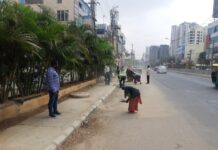If you are a North Indian and especially if you are a delhite , You must be aware of some popular places in Delhi such as : Mori Gate, TeesHazari, Mithai pul , Gurudwara Moti Bagh (Nanak Pura) etc . Now please read this write up to know the history behind these names ??
It was the year 1783 when Sikh leader Baba Baghel Singh conquered Delhi back from the Mughal king Shah Alam. On 11th March 1783, the Sikh army marched bravely to Delhi on horses and elephants and unfurled a Nishan Sahib at Red Fort. Thousands of Sikhs celebrate the day as Fateh Diwas, while the date as per the Gregorian calendar differs every year.
Born in the 1730s in village Jhabal Kalan, Amritsar, into a Dhillon Jatt family, his forefathers had converted to Sikhism during the time of Guru Arjan Sahib in the 1580s. Baghel Singh first invaded Delhi on January 8, 1774, and captured the area up to Shahdara. The second invasion was on July 17, 1775, when the Sikhs captured the area around the present-day Pahar Ganj and Jai Singhpura. Majority of the fighting took place where present-day New Delhi is located. Shortage of supplies forced Sikhs to temporarily halt their conquering spree, but Red Fort was the final aim. On 11th March 1783, the Sikhs entered the Red Fort in Delhi and occupied the Diwan-E-Aam where Mughal emperor Shah Alam II.
Emperor Shah Alam II reconciled with the Sikhs and offered treaty and accepted their terms, including construction of Gurudwaras on Sikh historical sites. Gurudwara Sis Ganj Sahib, where Guru Tegh Bahadur had been executed on the orders of Mughal king Aurangzeb and Gurudwara Rakab Ganj Sahib, where the Guru’s remains were cremated were established by him. He has also been credited with the establishment of Gurudwara Bangla Sahib, Gurudwara Bala Sahib, Gurudwara Majnu Ka Tilla, Gurudwara Moti Bagh, Gurudwara Mata Sundri and Gurudwara Baba Banda Singh Bahadur.
Not many know but even today Delhi stands witness to the brave act of Baba Baghel Singh. The place where Baba Baghel Singh stopped with his troop of 30,000 men in Delhi, is now known as Tees Hazaari. When the Mughal emperor got to know that the Sikhs are planning to attack Delhi, he ordered all the gates of the Red Fort be closed, especially the ones with access to the rations so that the Sikhs run out of food and go back. Some of the Sikhs, though, accidentally came across a mason who informed them about a part of the wall of the fort which had caved in, but the exterior was intact. The Sikhs reached the spot with the help of the mason and rammed logs of wood through the wall and entered. This place is now known as Mori Gate, where the Inter-State Bus Terminus (ISBT) now stands. After winning the Red Fort, the Sikhs distributed sweets. The place is now known as Mithai Pul.
This year, Delhi Fateh Diwas is being celebrated on 21st March.
When we talk about Indian history, especially pre-British era, why do we leave out the glorious history of the Sikhs? Their courage to stand up against the old traditions? The brutal treatment of the Sikhs on hands of Mughals? Why is Mughal history whitewashed before being taught in school syllabus across the country and Sikh history pushed away in the background? We all must pledge to read a bit more about our heroes, lest it is forgotten.









